Biology:List of marsupials by population
From HandWiki
Short description: none
This is a list of estimated global populations of Marsupials species. This list is not comprehensive, as not all Marsupials have had their numbers quantified.
| Common name | Binomial name | Population | Status | Trend | Notes | Image | |
|---|---|---|---|---|---|---|---|
| Brown-eared woolly opossum | Caluromys lanatus | 160 million[1]= | Least Concern(LC)[2] | ||||
| Brown Four-eyed Opossum | Metachirus nudicaudatus | 128 million[3]= | Least Concern(LC)[4] | ||||
| Gray Four-eyed Opossum | Philander opossum | 121 million[5]= | Least Concern(LC)[6] | ||||
| Linnaeus's Mouse Opossum | Marmosa murina | 104 million[7]= | Least Concern(LC)[8] | ||||
| Common wombat | Vombatus ursinus | 7,000-8,000[9] | LC[9] | It is widespread throughout the cooler and better-watered parts of southern and eastern Australia, including Tasmania, and in mountain districts as far north as the south of Queensland, but is declining in western Victoria and South Australia.[9] | 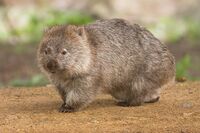
| ||
| Southern hairy-nosed wombat | Lasiorhinus latifrons | 70,000-130,000[10] | LC[10] | It is widespread throughout Western Australia, southern South Australia, and south-western New South Wales. They live in semiarid to arid grasslands and woodlands. [10] | 
| ||
| Northern hairy-nosed wombat | Lasiorhinus krefftii | 230[11] | CR[11] | It is one of the rarest land animals in the world and is native to the jungles of north-eastern Australia.[11] | 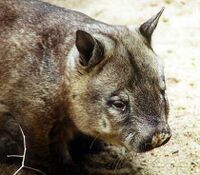
| ||
| Koala | Phascolarctos cinereus | 100,000-500,000[12] | VU[12] | It is widespread throughout the eucalyptus forests of southeastern and eastern Australia.[12] | 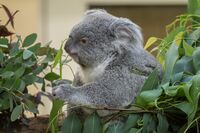
| ||
| Eastern Grey Kangaroo | Macropus giganteus | 16,057,783[13] | LC[13] | It is widespread throughout most of the eastern states of Australia, including Tasmania, in areas with more than 250 mm (10 in) of average annual rainfall. They are found in a variety of habitats, from semi-arid mallee scrub through woodlands to forested areas.[13] | 
| ||
| Western Grey Kangaroo | Macropus fuliginosus | 2,790,358[14] | LC[14] | It is widespread throughout the south-west Western Australia from south of Shark Bay to Laverton and the Nullarbor Plains.[14] | 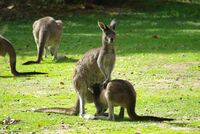
| ||
| Red Kangaroo | Osphranter rufus | 8,542,148[15] | LC[15] | It is widespread throughout the hot and dry deserts to open green-grass-lands of Australia.[15] | 
| ||
| Antilopine Kangaroo | Osphranter antilopinus | Unknown[citation needed] | LC[citation needed] | It is widespread across northern Australia in monsoonal tropical woodlands, and Common Wallaroos are found over most of Australia, especially around rocky outcrops.[citation needed] | 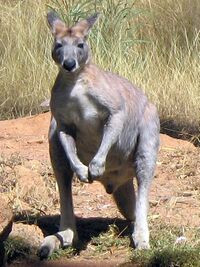
| ||
| Tasmanian Devil | Sarcophilus harrisii | 140,000[16] | EN[16] | It is widespread across the island state of Tasmania. Their Tasmanian range encompasses the entire island, although they are partial to coastal scrublands and forests.[16] | 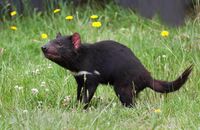
| ||
| Thylacine | Thylacinus cynocephalus | 0[17] | EX[17] | It was once widespread throughout the dry eucalyptus forests, wetlands, and grasslands of mainland Australia. Indigenous Australian rock paintings indicate that the Tasmanian wolf once lived throughout mainland Australia and New Guinea. [17] | 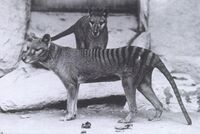
|
See also
- Lists of organisms by population
- Lists of mammals by population
- Lists of elephant species by population
References
- ↑ https://gitlab.com/milo-lab-public/mammal_biomass/-/blob/master/results/wild_land_mammal_biomass_inluding_populations.csv
- ↑ https://www.iucnredlist.org/species/3648/197310136
- ↑ https://gitlab.com/milo-lab-public/mammal_biomass/-/blob/master/results/wild_land_mammal_biomass_inluding_populations.csv
- ↑ https://www.iucnredlist.org/species/40509/197311536
- ↑ https://gitlab.com/milo-lab-public/mammal_biomass/-/blob/master/results/wild_land_mammal_biomass_inluding_populations.csv
- ↑ https://www.iucnredlist.org/species/40516/22176779
- ↑ https://gitlab.com/milo-lab-public/mammal_biomass/-/blob/master/results/wild_land_mammal_biomass_inluding_populations.csv
- ↑ https://www.iucnredlist.org/species/40505/197308868
- ↑ 9.0 9.1 9.2 9.3 Ambish K.R Borpuzari (2020). "Vombatus ursinus". IUCN Red List of Threatened Species 2020. https://www.nationalgeographic.com/animals/mammals/c/common-wombat/. Retrieved 2020-10-01.
- ↑ 10.0 10.1 10.2 10.3 Ambish K.R Borpuzari (2020). "Lasiorhinus latifrons". IUCN Red List of Threatened Species 2020. https://www.australianwildlife.org/wildlife/southern-hairy-nosed-wombat/. Retrieved 2020-10-01.
- ↑ 11.0 11.1 11.2 11.3 Ambish K.R Borpuzari (2020). "Lasiorhinus krefftii". IUCN Red List of Threatened Species 2020. https://www.australiangeographic.com.au/topics/wildlife/2015/09/northern-hairy-nosed-wombat/. Retrieved 2020-10-01.
- ↑ 12.0 12.1 12.2 12.3 Ambish K.R Borpuzari (2020). "Phascolarctos cinereus". IUCN Red List of Threatened Species 2020. https://www.iucnredlist.org/species/16892/166496779. Retrieved 2020-10-01.
- ↑ 13.0 13.1 13.2 13.3 Ambish K.R Borpuzari (2020). "Macropus giganteus". IUCN Red List of Threatened Species 2020. https://www.nationalgeographic.com/animals/mammals/e/eastern-gray-kangaroo/. Retrieved 2020-10-01.
- ↑ 14.0 14.1 14.2 14.3 Ambish K.R Borpuzari (2020). "Macropus fuliginosus". IUCN Red List of Threatened Species 2020. https://www.iucnredlist.org/species/40563/21953972. Retrieved 2020-10-01.
- ↑ 15.0 15.1 15.2 15.3 Ambish K.R Borpuzari (2020). "Macropus rufus". IUCN Red List of Threatened Species 2020. https://www.iucnredlist.org/species/40567/21953534. Retrieved 2020-10-01.
- ↑ 16.0 16.1 16.2 16.3 Ambish K.R Borpuzari (2020). "Sarcophilus harrisii". IUCN Red List of Threatened Species 2020. https://www.iucnredlist.org/species/40540/10331066. Retrieved 2020-10-02.
- ↑ 17.0 17.1 17.2 17.3 Ambish K.R Borpuzari (2020). "Thylacinus cynocephalus". IUCN Red List of Threatened Species 2020. https://www.iucnredlist.org/species/21866/21949291. Retrieved 2020-10-18.
 |

